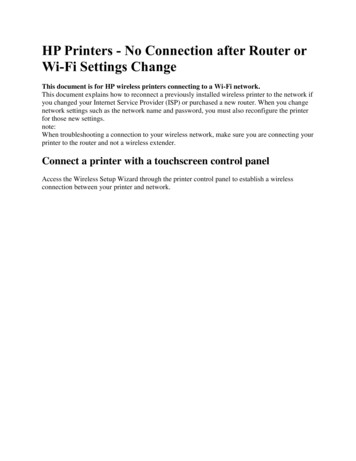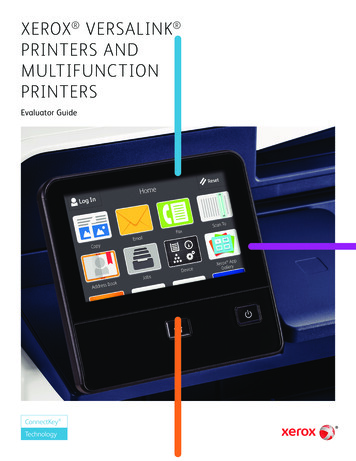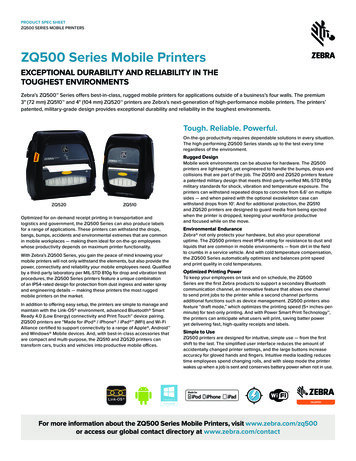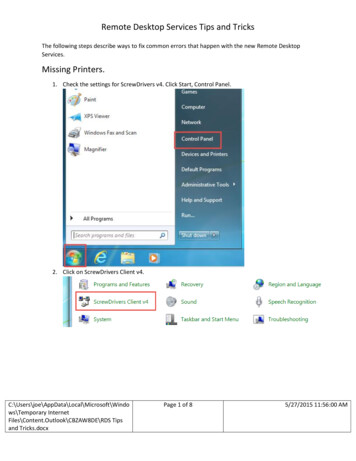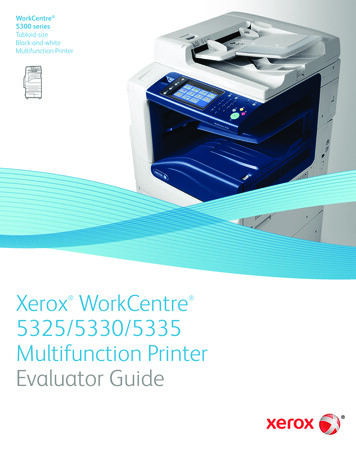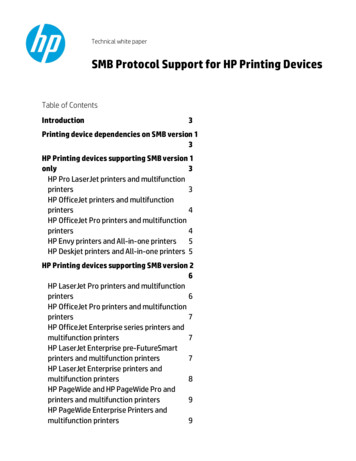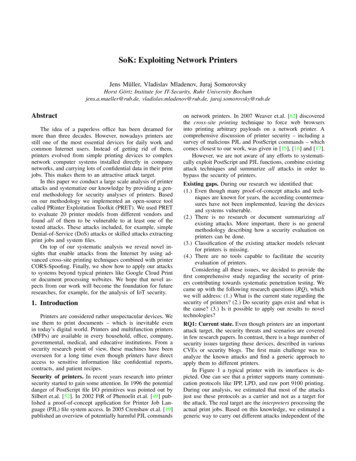
Transcription
SoK: Exploiting Network PrintersJens Müller, Vladislav Mladenov, Juraj SomorovskyHorst Görtz Institute for IT-Security, Ruhr University Bochumjens.a.mueller@rub.de, vladislav.mladenov@rub.de, juraj.somorovsky@rub.deAbstractThe idea of a paperless office has been dreamed formore than three decades. However, nowadays printers arestill one of the most essential devices for daily work andcommon Internet users. Instead of getting rid of them,printers evolved from simple printing devices to complexnetwork computer systems installed directly in companynetworks, and carrying lots of confidential data in their printjobs. This makes them to an attractive attack target.In this paper we conduct a large scale analysis of printerattacks and systematize our knowledge by providing a general methodology for security analyses of printers. Basedon our methodology we implemented an open-source toolcalled PRinter Exploitation Toolkit (PRET). We used PRETto evaluate 20 printer models from different vendors andfound all of them to be vulnerable to at least one of thetested attacks. These attacks included, for example, simpleDenial-of-Service (DoS) attacks or skilled attacks extractingprint jobs and system files.On top of our systematic analysis we reveal novel insights that enable attacks from the Internet by using advanced cross-site printing techniques combined with printerCORS-Spoofing. Finally, we show how to apply our attacksto systems beyond typical printers like Google Cloud Printor document processing websites. We hope that novel aspects from our work will become the foundation for futureresearches, for example, for the analysis of IoT security.1. IntroductionPrinters are considered rather unspectacular devices. Weuse them to print documents – which is inevitable evenin today’s digital world. Printers and multifunction printers(MFPs) are available in every household, office, company,governmental, medical, and educative institutions. From asecurity research point of view, these machines have beenoverseen for a long time even though printers have directaccess to sensitive information like confidential reports,contracts, and patient recipes.Security of printers. In recent years research into printersecurity started to gain some attention. In 1996 the potentialdanger of PostScript file I/O primitives was pointed out bySilbert et.al. [52]. In 2002 FtR of Phenoelit et.al. [49] published a proof-of-concept application for Printer Job Language (PJL) file system access. In 2005 Crenshaw et.al. [19]published an overview of potentially harmful PJL commandson network printers. In 2007 Weaver et.al. [62] discoveredthe cross-site printing technique to force web browsersinto printing arbitrary payloads on a network printer. Acomprehensive discussion of printer security – including asurvey of malicious PJL and PostScript commands – whichcomes closest to our work, was given in [15], [16] and [17].However, we are not aware of any efforts to systematically exploit PostScript and PJL functions, combine existingattack techniques and summarize all attacks in order tobypass the security of printers.Existing gaps. During our research we identified that:(1.) Even though many proof-of-concept attacks and techniques are known for years, the according countermeasures have not been implemented, leaving the devicesand systems vulnerable.(2.) There is no research or document summarizing allexisting attacks. More important, there is no generalmethodology describing how a security evaluation onprinters can be done.(3.) Classification of the existing attacker models relevantfor printers is missing.(4.) There are no tools capable to facilitate the securityevaluation of printers.Considering all these issues, we decided to provide thefirst comprehensive study regarding the security of printers contributing towards systematic penetration testing. Wecame up with the following research questions (RQ), whichwe will address: (1.) What is the current state regarding thesecurity of printers? (2.) Do security gaps exist and what isthe cause? (3.) Is it possible to apply our results to noveltechnologies?RQ1: Current state. Even though printers are an importantattack target, the security threats and scenarios are coveredin few research papers. In contrast, there is a huge number ofsecurity issues targeting these devices, described in variousCVEs or security blogs. The first main challenge was toanalyze the known attacks and find a generic approach toapply them to different printers.In Figure 1 a typical printer with its interfaces is depicted. One can see that a printer supports many communication protocols like IPP, LPD, and raw port 9100 printing.During our analysis, we estimated that most of the attacksjust use these protocols as a carrier and not as a target forthe attack. The real target are the interpreters processing theactual print jobs. Based on this knowledge, we estimated ageneric way to carry out different attacks independent of the
nterpreterIPPLPDFurtherInterpreterSMB(PCL, PDF, .)Figure 1: Printer overview containing relevant componentsused during the security analysis. Our research concentrateson two components provided by almost every printer device:PostScript and PJL interpreters.supported communication protocols by the printer. Thus, inthis work, all attacks concentrate on two of the most usedand implemented interpreters – PostScript and PJL.In addition, we extended the cross-site printing techniques by introducing our novel attack we call CORSSpoofing. The attack allows an attacker to get a backchannelfrom the printer and thus read the results of the attack, whichwas previously not possible.In order to facilitate our analysis, we implemented asemi-automated tool named PRinter Exploitation Toolkit(PRET), which we used during our evaluation. The results ofthis evaluation are devastating – each of 20 tested printers issusceptible to multiple attacks ranging from simple Denialof-Service (DoS) attacks to complex cross-site printing attacks leading to leakage of printed documents or storedsystem files.RQ2: Existing gaps. Widespread printer languages likePJL and PostScript offer security sensitive features such asaccess to the file system. Even though many of the securityissues are not new, these were not taken into account by thevendors. Moreover, our analysis revealed an existing gapregarding the security of PostScript and PJL. There is nosurvey regarding the existing risks and the according countermeasures. Even if a printer vendor is aware of the existingrisks, there is no document summarizing the Best CommonPractices (BCP). Such BCP documents are important fromthe security perspective since they give a good guidelinefor developers. BCPs are established for technologies likeTLS [51], OAuth [22] or Web Application Security [1],and reduce the security risks of faulty implementations andskipped security checks.RQ3: Novel research directions. Based on our findings, thequestion arises whether it is possible to apply our attacks toother systems than printers. Such systems are cloud printingservices, online available PostScript interpreters, and even3D printers. Our main goal is to determine which systemsshould be in the scope of future security research and todocument possible attack scenarios.To prove the applicability of our analyzing methodologyand attacks, we provide a practical analysis of Google CloudPrint and websites converting PostScript files to PDF. Theresult of our analysis reveals existing security issues leadingto information leakage. Intentionally, we do not providea comprehensive analysis of these systems due to theircomplexity and feature diversity.Contributions. Our contributions can be summarized asfollows: We provide a comprehensive research regarding attacksapplicable on printing devices. We systematize our findings, establish a generic methodology, and define attackermodels enabling the analysis of printers. We facilitate the security evaluation by implementing oursemi-automated open-source tool PRET capable to carryout multiple attacks in different printing languages likePostScript and PJL. We provide an evaluation of 20 different printers revealingserious security flaws on all printers ranging from efficientDoS to attacks leaking sensitive information. We prove the applicability of our methodology and findings by evaluating systems beyond printers like GoogleCloud Print. We address future researches by summarizing different technologies where our finding can beapplied too.Responsible disclosure. We responsibly disclosed all security vulnerabilities to printer manufacturers and to administrators responsible for vulnerable interpreter processingwebsites. Google rewarded our findings with 3133.7.2. FoundationsData can be sent to a printer by USB/parallel cable orover a network. In this work, we focus on network printingbut most of the presented attacks can also be performedagainst local printers.Figure 2 depicts an overview of the encapsulation ofprinter languages and protocols.Figure 2: Encapsulation of printer languages2.1. Device control protocolsOne approach to define a common standard for printerdevice management was Network Printing Alliance Protocol(NPAP). However, it is only supported by Lexmark. Otherprinter manufacturers instead use Simple Network Management Protocol (SNMP) for device control as introduced inthe following.SNMP. SNMP is a UDP based protocol designed to managevarious network components like routers and servers. The
architecture is defined in [27]. Information offered by amanaged system is not subject to the standard itself, butdefined in separate hierarchical database files, so calledManagement Information Bases (MIBs). An MIB consistsof various Object Identifier (OID) entries, each identifyinga variable to be monitored. An example of retrieving thedevice description (hrDeviceDescr) is shown in Listing 1.123 s n m p g e t v1 c p u b l i c p r i n t e r \iso . 3 . 6 . 1 . 2 . 1 . 2 5 . 3 . 2 . 1 . 3 . 1 " hp L a s e r J e t 4250"Listing 1: SNMP request to read the device descriptionWhile SNMP is not printer-specific, many printer manufacturers have published MIBs for their network printermodels. A generic approach to create a vendor-independent"Printer MIB" was discussed in [12]. As a stand-alone language, we will make use of SNMP only to reset the device tofactory defaults. However, SNMP can be embedded withinPJL and therefore included into arbitrary print jobs.control languages like HP’s Printer Management Language(PML) are designed to affect not only a single print job butthe entire device.Printer Job Language (PJL). PJL was originally introduced by HP but soon became a de-facto standard for printjob control. PJL "resides above other printer languages" [44]and can be used to change settings like paper tray or size.Furthermore, PJL is not limited to the current print job assome settings can be made permanent. PJL can also beused to change the printer’s display or read/write files onthe device. Interestingly, there are many dialects as vendorstend to support only a subset of the commands listed inthe PJL reference and instead add proprietary ones. TypicalPJL commands to set the paper size and the number ofcopies before switching the interpreter to PostScript modeare shown in Listing 2.1232.2. Printing channelThe most common network printing protocols supportedby printer devices are the Internet Printing Protocol (IPP),Line Printer Daemon (LPD), Server Message Block (SMB)and raw port 9100 printing. Each protocol has specificfeatures like print job queue management, accounting, etc.In this work we do not attack printing protocols directly butinstead use them as a channel to deploy malicious PostScriptand PJL code which can be received and is simply forwardedby all network printing protocols as shown in Figure 1.Raw port 9100 printing is the default method used byCUPS and the Microsoft Windows printing architecture tocommunicate with network printers and considered as ‘thesimplest, fastest, and generally the most reliable networkprotocol used for printers’ [55]. Raw port 9100 printing,also referred to as JetDirect or AppSocket is not a printingprotocol by itself. Instead all data sent is directly processedby the printing device, just like a parallel connection overTCP. In contrast to LPD, IPP or SMB, interpreted printerlanguages can send direct feedback to the client, includingstatus and error messages. Such a bidirectional channel isnot only perfect for debugging, but gives us direct access toresults of PostScript and PJL commands. Therefore, raw port9100 printing – which is supported by almost any networkprinter – is used as the primary channel in our securityanalysis and the prototype implementation.@PJL SET PAPER A4@PJL SET COPIES 10@PJL ENTER LANGUAGE POSTSCRIPTListing 2: Setting paper size and copies with PJLIn this work, PJL is used for physical storage damageand to gain access to the printer’s memory and file system.Printer Management Language (PML). PML is a proprietary language to control HP printers. It basically combines the features of PJL and SNMP. Publicly availabledocumentation has not been released, however parts of thestandard were leaked by the LPRng project. According to thespecification [45] PML is "an object-oriented request-replyprinter management protocol". PML is embedded withinPJL and can be used to read and set SNMP values on aprinter device. This is especially interesting if a firewallblocks access to SNMP services (161/udp), but an attackeris still able to print. The use of PML within a print job isdemonstrated in Listing 3.get len. M IB12OIDz} {z} { z} { z} { @PJL DMINFO ASCIIHEX " 0000 06 03 0302010301 " " . . . 6870204c617365724a65742034323530 " {z}hpLaserJet4250 (hexdecimal)Listing 3: PML request to read the device descriptionAs one can see, with the help of PML it is possible toinvoke SNMP commands embedded in PJL. In this work,PML is used to reset the printer to factory-defaults.2.4. Page Description Language (PDL)2.3. Job/printer control languageA job control language manages settings like outputtrays for the current print job. While it usually sits asan optional layer between the printing protocol and thepage description language, functions can overlap. Examples of vendor-specific job control languages are the Xerox Job Control Language (XJCL), Epson Job Language(EJL), Canon Common Peripheral Controlling Architecture(CPCA) and PJL – which is supported by a variety ofprinters and will be discussed below. In addition, printerA PDL specifies the appearance of the actual document.It must however be pointed out that some PDLs offerlimited job control, so a clear demarcation between pagedescription and printer/job control language is not alwayspossible. The function of a printer driver is to translatethe file to be printed into a PDL that is understood by theprinter model. There are various proprietary page descriptionlanguages like Kyocera’s PRESCRIBE, Samsung PrinterLanguage (SPL), Xerox Escape Sequence (XES), CanonPrinting System Language (CaPSL), Ricoh Refined Printing
Command Stream (RPCS), Epson Standard Code for Printers (ESC/P) which is mostly used in dot matrix printers orHewlett-Packard Graphics Language (HP-GL) and HP-GL/2which have been designed for plotters. Support for directPortable Document Format (PDF) and XML Paper Specification (XPS) printing is also common on newer printers.The most common ‘standard’ page description languageshowever are the Printer Command Language (PCL) (whichis hard to exploit from a security perspective due to itslimited capabilities) and PostScript.PostScript. The PostScript language was invented by AdobeSystems between 1982 and 1984. It has been standardized asPostScript Level 1 [50], PostScript Level 2 [61], PostScript3 [33], and in various language supplements.While PostScript has lost popularity in desktop publishing and as a document exchange format to PDF, it is stillthe preferred page description language for laser printers.PostScript is a stack-based, turing-complete programming language consisting of about 400 operators for arithmetics, stack and graphic manipulation and various datatypes such as arrays or dictionaries.Technically spoken, access to a PostScript interpretercan already be classified as code execution because anyalgorithmic function can theoretically be implemented inPostScript.Example code to print to stdout is given in Listing 4.12%!( Hello world ) p r i n tListing 4: Example PostScript documentIn this work, PostScript is used for a variety of attackssuch as DoS caused by infinite loops, print job manipulationand retention as well as access to the printer’s file system.3. MethodologyIn this section, we introduce our methodology to collect,analyze, and attack printers.Acquiring the printers. Test printer devices were collectedas donations by various university chairs and facilities.While our actual goal was to assemble a pool of printerscontaining at least one model for each of the top tenmanufacturers, we practically took what we could get. Ifavailable, the latest firmware was installed prior to any teststo make sure any vulnerabilities discovered had not beenfixed in the meantime. The assembled devices are not brand–new anymore, nor does the pool of test units contain modelsfor all the top vendors. It should however represent a goodmix of printers and MFPs used in a typical university oroffice environment.Analyzing approach. We surveyed which security sensitivefeatures exist in the PostScript and PJL standards and theirproprietary extensions. We created a list with all potentialattacks, which can be carried out and classified them.Besides DoS attacks, bypassing protection mechanismsand print job manipulation, we were especially interestedin job retention and access to the file system which is alegitimate feature of both languages.To facilitate the analysis, we implemented a Python 2.7application – PRET – providing semi-automated tests.We evaluated each attack and examined the impact. Forexample, if stored print jobs could be read by an attacker.Deployment channels. For detected weaknesses, we evaluated which attacker models are sufficient to carry out thepresented attacks. Therefore, we researched which channelsexists to deploy malicious print jobs. Apart from director network access to the device, we especially focused onextending known cross-site printing techniques.4. Attacker ModelBased on the existing deployment channels, we providean attacker model, which reflects the threat models weextracted during our research. Our default attacker is anattacker with a network access (AM2), meaning anyone whocan access the targeted printer via TCP/IP, for example anemployee. However, most attacks described in this work canalso be carried out by a weaker web attacker (AM3).Physical Access (AM1). A local attacker is the strongestattacker. She has physical access to the printer device for alimited amount of time. Her capabilities include: (1.) plugging in external storage media like memory cards or USBsticks, (2.) temporarily connecting to the printer device viaUSB or parallel cable, (3.) changing control panel settingsand pressing certain key combinations.AM1 is a strong attacker model. However, it is realisticfor most institutions and companies. Gaining physical accessto printer devices can generally be considered as less hardthan it is for other network components like servers orworkstations. This is because printers are usually sharedby and accessible to a whole department. Sneaking into anunlocked copy room and launching a malicious print jobfrom USB stick is only a matter of seconds.Network Access (AM2). An active network participantcan connect to a printer device via a TCP/IP network.Specifically, she is capable of: (1.) accessing all networkservices offered by the device, including but not limitedto web, FTP, SMB, SNMP, LPD, IPP, or raw port 9100printing, (2.) establishing various connections over a longerperiod.PrinterRAWIPPLPDUSBMaliciousPrint JobAppSMBFigure 3: The attacker can send malicious print jobs byaccessing the printer via the internal network.Attacking intranet printers is an attractive goal of aninsider who wants to obtain the payroll print jobs of thedepartment manager or colleges from a shared device. An
additional treat related to this attacker model is the possibility that an honest employee prints out a file received froma malicious colleague from another company, for example,a contract or project deliverable.It is also worth mentioning that many new printers bringtheir own wireless access point to allow easy printing, forexample, via AirPrint compatible mobile apps [34]. Whileconnecting to a printer through Wi-Fi requires the attackerto stay physically close to the device, it may be feasible toperform her attack from outside of the targeted institutiondepending on the signal strength.Web Attacker (AM3) – Cross-site printing. AM3 is theweakest attacker model and thus requires less resourceson the attacker’s side. The so called cross-site printingtechnique [62] is directly related to this attacker model andenables the execution of different attacks even outside thenetwork where the printer is located. Cross-site printing isused as a carrier for the attack vectors.PrinterRAWMaliciousPrint JobIPPLPDUSBSMBBrowserMaliciousPrint JobMaliciousWebsiteFigure 4: The attacker can send malicious print jobs throughthe end-user’s browser.The only requirement in this attacker model is that aweb attacker controls the content of a website and is ableto lure a victim to this website. By visiting the website,the attacker can deploy JavaScript code to be processed bythe victim’s web browser. Thus, the attacker initiates AJAXrequests to port 9100 of the victim’s intranet printer andsends raw PostScript or PJL commands. Consequentially theprinter executes the malicious code. This way the attackercan reach even printers which are not directly visible fromthe Internet.An important limitation of this attacker model is themissing backchannel. In other words, the attacker can sendmalicious commands to the printer, but cannot get the result.The reason for this limitation is the same-origin policywithin the browser disabling the cross-site access.Out-of-scope. It must be noted that AM1, AM2 and AM3are not the only possible attacker models. For example, wedo not consider any active network attacker controlling thecommunication between the end-user and the printer.or even to cause long-term storage damage. It is applicablein all attacker models.Any network resource can be slowed down or even madecompletely unavailable to legitimate end-user by consumingits resources in terms of CPU/memory or bandwidth. Inour work, we concentrate on DoS attacks based on printjob content. Thus, we do not consider classical attacks likeSYN flooding [14] or more advanced Slowloris attacks [25].Trivial attacks like sending a lot of print jobs or blocking thetransmission channel (port 9100/tcp) are also out of scope.Document processing. Page description languages allowing infinite loops or calculations, which require a lot ofcomputing time, can be abused to keep the printer’s RasterImage Processor (RIP) busy. Examples of this are PostScriptprograms or complex HP-GL calculations. Malicious PJL orPostScript commands embedded in a document can furtherbe used to completely disable printing functionality.Physical damage. Long-term settings for printers and otherembedded devices are stored in Non-Volatile RandomAccess Memory (NVRAM) which is traditionally implemented either as Electrically Erasable Programmable ReadOnly Memory (EEPROM) or as flash memory. Both components have a limited lifetime. On early HP LaserJets ‘flashchips would only sustain about 1000-2000 cycles of rewriting’ [23]. Today, vendors of flash memory guaranteeabout 100,000 rewrites before any write errors may occur.This number sounds large, but PJL and PostScript print jobsthemselves can change long-term settings like default papertray media sizes or even passwords. Doing this a lot of timeson purpose can be a realistic attack scenario leading to physical destruction of the NVRAM. Such ideas are not new: Thefirst PostScript malware in the wild, which appeared in 1990[26], applied the setpassword operator multiple times whichquickly led to the password becoming unchangeable becauseof very limited EPROM write cycles on early LaserWriterprinters. Note that printing functionality itself is not affectedby this attack, but fixed settings like a high default numberof copies can make the device practically unusable.AMAM1AM2AM3App.DescriptionThe attacker can sneak into the copy room anddisable printing functionality to others via USB.The attacker can send malicious print jobs via port9100 and physically destroy the device’s NVRAM.The attacker can use cross-site printing techniquesto make intranet printers of her victim unavailable.TABLE 1: Applicability and examples of DoS attacks regarding the defined attacker models.5. AttacksIn the following we collect the attacks from the literatureand propose new approaches. At the end of each section wesummarize the attack goals and its applicability in differentattacker models.5.1. Denial-of-Service (DoS)The goal of the DoS attack is to keep the printer busy byprocessing malicious files, to disable printing functionality,5.2. Protection bypassThe idea of the attack described in this section is tocircumvent protection mechanisms.Access to printers can be restricted based on differentpolicies. A formal policy-based security model for accesscontrol on MFPs has recently been proposed by Lukusa etal.[40]. Typically, security-critical management capabilitiesare granted to an administrator and document printing can
be executed by a certain group of end-users. However, thesesecurity measures can be bypassed if the device is reset tofactory defaults or if backdoors are deployed.Factory defaults. Resetting a device to factory defaults isa security-critical functionality as it overwrites protectionmechanisms like user-set passwords. This can usually bedone by pressing a special key combination on the printer’scontrol panel. However, physical access to the device isnot always an option. Interestingly, via SNMP, PML andPostScript commands a reset can be done too.Backdoors. Another way to bypass protection mechanismson printer devices are backdoors. There exist several CVEsdescribing backdoors in printers. For example, Kyocera3830 printers contained a backdoor that allowed remoteattackers to read and modify configurations via stringsthat started with "!R!SIOP0" [5]. Samsung (and someDELL) printers enabled a remote attacker to execute actions with administrator privileges using hardcoded SNMPcommands [3]. This was possible even if SNMP has beendisabled on the affected printers.AMAM1AM2AM3App.DescriptionAn attacker without a valid PIN can press certaincontrol panel keys to restore factory defaults.The attacker can restore factory defaults via SNMPand bypass the embedded web servers password.The attacker can use cross-site printing techniquesto disable the printer’s protection mechanisms.TABLE 2: Applicability and examples of factory restoreattacks regarding the defined attacker models.5.3. Print job manipulationThe goal of this attack is to infect a printer device withmalware, thereby forcing it to manipulate further documentswhile printing. If an attacker can alter print jobs, she canfundamentally change the resulting printout. The impactdepends on the context of the print job and can range fromsimple pranks to serious business impairment.Content overlay. One simple way to manipulate the appearance of printouts is to use overlays. PCL has a documentedfunction to put overlay macros on top of a document.Unfortunately, this feature is limited to the current print joband cannot be made permanent. PostScript does not offersuch functionality by default, however it can be programmedinto by redefining PostScript operators: When a PostScriptdocument calls an operator, the first version found on thedictionary stack is used. Operators usually reside in thesystemdict dictionary, however by placing a new versioninto the userdict dictionary, operators can practically beoverwritten because the user-defined version is the firstone found on the dictionary stack as shown in Figure 5.Using the exitserver operator, such changes can be madepermanent – at least until the printer is restarted.Once redefined, when further legitimate documents areprinted and call this operator, the attacker’s version will beexecuted – which can contain arbitrary graphics to overlay.This attack works even if the document has been digitallyFigure 5: The PostScript dictionary stacksigned and verified by a print server, because the documentitself remains untouched and the manipulation step happensimmediately before printing.Content replacement. This attack does not only add customcontent, but parses and replaces existing content in thedocument. Especially replacing text seems to be an attractivefunction, introducing new possibilities to the attacker asshe can go for targeted manipulation or randomly transposedigits and introduce misspellings.AMAM1AM2AM3App.DescriptionThe attacker can connect via USB and send maliciousPostScript which puts an overlay on further print jobs.The attacker can abuse port 9100 to force the printerto introduce misspellings into a competitor’s printouts.The attacker can use cross-site printing for targetedmanipulation like altering digits in a printed contract.TABLE 3: Applicability and examples of print job manipulation attacks regarding the defined attacker models.5.4. Information disclosureIn the following we introduce information leakage attacks. These attacks attempt to access the printer memoryand file system, or capture printed documents and credentials. In addition, we present our novel attack CORSSpoofing extendin
ers contributing towards systematic penetration testing. We came up with the following research questions (RQ), which we will address: (1.) What is the current state regarding the security of printers? (2.) Do security gaps exist and what is the cause? (3.) Is it possible to apply our results to novel technologies? RQ1: Current state.


